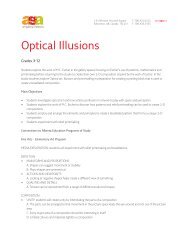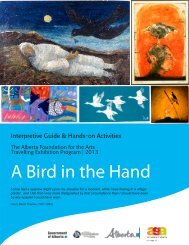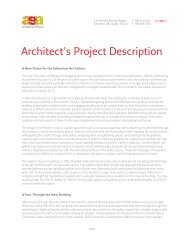Urban Animals - Art Gallery of Alberta
Urban Animals - Art Gallery of Alberta
Urban Animals - Art Gallery of Alberta
Create successful ePaper yourself
Turn your PDF publications into a flip-book with our unique Google optimized e-Paper software.
The <strong>Alberta</strong> Foundation for the <strong>Art</strong>s Travelling Exhibition Program<br />
The History <strong>of</strong> Abstraction: A Survey con’t<br />
Abstraction in European <strong>Art</strong> History<br />
Wassily Kandinsky (1866-1944) is usually credited<br />
with making the first entirely non-representational<br />
painting in 1910. The history <strong>of</strong> abstraction in<br />
European art, however, begins before<br />
Kandinsky in the later decades <strong>of</strong> the 19th<br />
century with the work <strong>of</strong> the French<br />
Impressionist artists such as Claude Monet, Paul<br />
Cézanne and Georges Seurat. While the work <strong>of</strong><br />
these artists was grounded in visible reality, their<br />
methods <strong>of</strong> working and artistic concerns began the<br />
process <strong>of</strong> breaking down the academic restrictions<br />
concerning what was acceptable subject matter in<br />
art, how artworks were produced and, most<br />
importantly, challenged the perception <strong>of</strong> what a<br />
painting actually was.<br />
Wassily Kandinsky<br />
Composition VII, 1913<br />
The Tretyalov <strong>Gallery</strong>, Moscow<br />
Paul Cézanne<br />
Maison Arbies, 1890-1894<br />
The Tretyalov <strong>Gallery</strong>, Moscow<br />
Claude Monet<br />
Haystacks (sunset), 1890-1891<br />
Museum <strong>of</strong> Fine <strong>Art</strong>s, Boston<br />
George Seurat<br />
A Sunday Afternoon on the Island <strong>of</strong> La<br />
Grande Jatte, 1884-1886<br />
Radicals in their time, early Impressionists broke the rules <strong>of</strong> academic painting. They began<br />
by giving colours, freely brushed, primacy over line. They also took the act <strong>of</strong> painting out <strong>of</strong> the<br />
studio and into the modern world. Painting realistic scenes <strong>of</strong> modern life, they portrayed overall<br />
visual effects instead <strong>of</strong> details. They used short “broken” brush strokes <strong>of</strong> mixed and pure<br />
unmixed colour, not smoothly blended or shades as was customary, in order to achieve the<br />
effect <strong>of</strong> intense colour vibration.<br />
The vibrant colour used by the Impressionist artists was adopted by their successors,<br />
the Fauve artists. The Fauves were modern artists whose works emphasized painterly qualities<br />
and strong colour over the representational or realistic values retained by the Impressionists.<br />
This group, which basically operated from 1905 to 1907, was led by Henri Matisse and André<br />
Derain.<br />
AFA Travelling Exhibition Program, Edmonton, AB. Ph: 780.428.3830 Fax: 780.421.0479<br />
youraga.ca

















